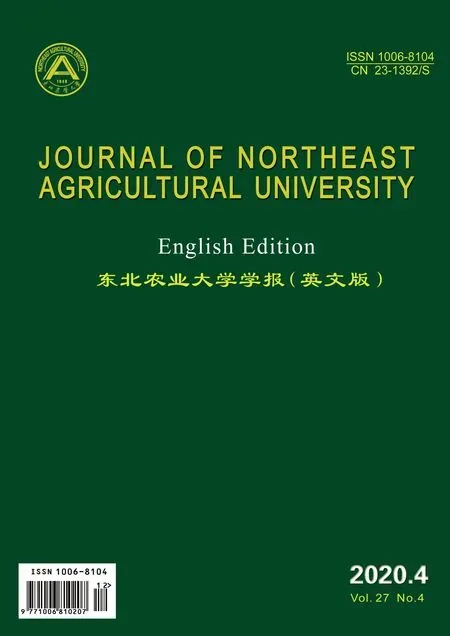Length-weight and Length-length Relationships for Nine Freshwater Species from Huaihongxinhe River, Huaihe River Basin, East China
Zhang Yun-long, Ma Huan, Mao Ying-rui, and Chen Fan
College of Animal Science and Technology, Anhui Agricultural Universtiy, Hefei 230036, China
Abstract: The present paper provided length-weight relationship (LWR) and length-length (LLR) relationship for the nine freshwater species from Huaihongxinhe River, a tributary of Huaihe River in east China. The data was based on monthly sampling (from August 2016 to December 2016) of the nine fish species. Samples were obtained using barrier net, gill net and ground cage in Huaihongxinhe River. The log-transformed data were used to establish the standard length-body weight and standard length-total length relationships by linear regression analyses. This study would be useful for fishery management and conversation in Huaihe River Basin.
Key words: growth, length-weight relationship, length-length relationship, Huaihongxinhe River
Introduction
Length-weight relationship (LWR) has many applications in fisheries assessment, monitoring of fish stocks and ecological studies, as well as for species conservation programs (Froese, 2006; Vicentinet al.,2012). The LWR may also be used in estimating several components of fish population dynamics models (Gubiani and Horlando, 2014).
Huaihongxinhe River, a tributary of Huaihe River in east China, is considered a national Aquatic Germplasm Resources Conservation Zones, and some conservation measures have been conducted in this area for several years (e.g. artificial releasing). However,knowledge about the biological characteristics of fishes resident to Huaihongxinhe River is still very limited.The nine species,Abbottina rivularis(Basilewsky,1855),Carassius auratus(Linnaeus, 1758),Chanodichthys dabryi(Bleeker, 1871),Coilia brachygnathus(Kreyenberg et Pappenheim, 1903),Culter alburnus(Basilewsky, 1855),Hypophthalmichthys molitrix(Valenciennes, 1844),Parabramis pekinensis(Basilewsky, 1855),Pseudorasbora parva(Temminck and Schlegel, 1846) andRhodeus sinensis(Günther,1868), are commonly found in Huaihongxinhe River,thus the LWRs and LLRs of these fish species are helpful for fishery evaluation and management in the conservation zones. However, both fishery and ecological information regarding these species are limited. Therefore, the aim of this study was to estimate the LWRs and LLRs for the nine fish species from Huaihongxinhe River, which might be useful for conservation and management of these resources.
Materials and Methods
Fish were collected from three different localities at different times using three types of fish gear (barrier net, gill net and ground cage). The total length (TL)and standard length (SL) were measured to the nearest 0.1 cm using a measuring ruler, body weight (BW)were weighed to the nearest 0.01 g using a digital balance. The log-transformed data were used to establish the total length-body weight relationships by linear regression analyses (Ricker, 1975; Froese,2006). The LWR equation was LogBW=Loga+bLogTL, where,awas the intercept andbwas the regression coefficient. The relationships between standard length and the total length of these species were also established using linear regression analyses and the LLR equation wasSL=a+bTL, where,awas the intercept andbwas the regression coefficient. The 95% confidence intervals (CI) of parametersaandband the coefficient of regression (r2) were determined using the SPSS 18.0 (SPSS Inc. Chicago, IL, USA).
Results
Sample size range, LWR parametersaandb, 95%confidence intervals and correlation coefficient (r2)are shown in Table 1. LLR parametersaandb, 95%confidence intervals and correlation coefficient (r2) are shown in Table 2.

Table 1 Descriptive statistics and length-weight relationship (LWR) parameters for the nine fish species

Table 2 Descriptive statistics and SL-TL relationship parameters for the nine fish species
Discussion
Length-weight relationships for the nine fish species from a total of 790 individuals were determined.The values ofbfor these species were within normal ranges of 2.5-4.0, as suggested by Brown (1957). All the regressions were highly significant (P<0.001),withr2values ranging between 0.967 and 0.992. Only two LWRs informations were available in FishBase(Froese and Pauly, 2018). ForR. sinensis, both the maximum and minimum total lengths exceeded those reported in FishBase. Thebvalue ofC. dabryiin the present study (3.402) was higher than that reported by Liuet al. (2012) from the Xingkai Lake(2.621) and Wanget al. (2012) from the Tian-ezhou Oxbow (3.28). An obvious lowerbvalue ofC. brachygnathusin the present study (2.678) as compare to previous study (3.11) was observed(Wanget al., 2012). ForC. auratus,H. molitrix,P. pekinensisandP. parva, thebvalues in the present study (3.159, 3.303, 3.342 and 3.147) were on the high side compared to the previous data presented on FishBase (2.732-3.336, 2.740-3.370, 2.890-3.322 and 2.900-3.370) (Froese and Pauly, 2018).
Thebvalue of LWR showed isometric growth whenb=3, it indicated positive allometry whenb>3,and negative allometry whenb<3 (Tarkanet al.,2006). Isometric growth forR. sinensis, negative allometry forA. rivularisandC. brachygnathusand positive allometry forC. auratus,C. dabryi,C. alburnus,H. molitrix,P. pekinensisandP. parvawere observed in the present study. Positive or negative allometry indicated a rounder or slimmer body, respectively,whereas isometric growth showed that the body grew in the same proportion in all the dimensions (Gaygusuzet al., 2013). Compared to the previous data presented on FishBase (Froese and Pauly, 2018), differentbvalues were calculated in the present study. Multiple factors,such as the number and the length range of sampled fish, seasonality, habitat, gonad ripeness, stomach fullness and grow phase, would lead to differences inbvalues (Sharmaet al., 2015), differentbvalues in this study might indicate the specificities of these fish species in Huaihe River Basin.
Conclusions
In conclusion, the data obtained by this study provided basic biological information that would be useful for fishery conservation and management in the national aquatic germplasm resource conservation zones.
 Journal of Northeast Agricultural University(English Edition)2020年4期
Journal of Northeast Agricultural University(English Edition)2020年4期
- Journal of Northeast Agricultural University(English Edition)的其它文章
- Evaluation of Related Traits of GmTST2.1 and ZmGIF1 Genes in Soybean (Glycine Max)
- Soybean Leaf Morphology Classification Based on FPN-SSD and Knowledge Distillation
- CRISPR/Cas9-based Editing of Acetyl-CoA Carboxylase (ACC1) Gene in Barley
- A Bicycle Tourism Based Study on Planning and Designing of Urbanrural Recreational Greenway
—— A Case Study of Harbin City - Effects of Two Chelating Agents on Availability of Calcium and Phosphorus in Black Soil of Vegetable Fields
- Effects of Crop Rotation and Microbial Fertilizer on Nutrient Absorption and Beneficial Bacterium Abundance in Rhizosphere of Continuous Cropped Eggplant
